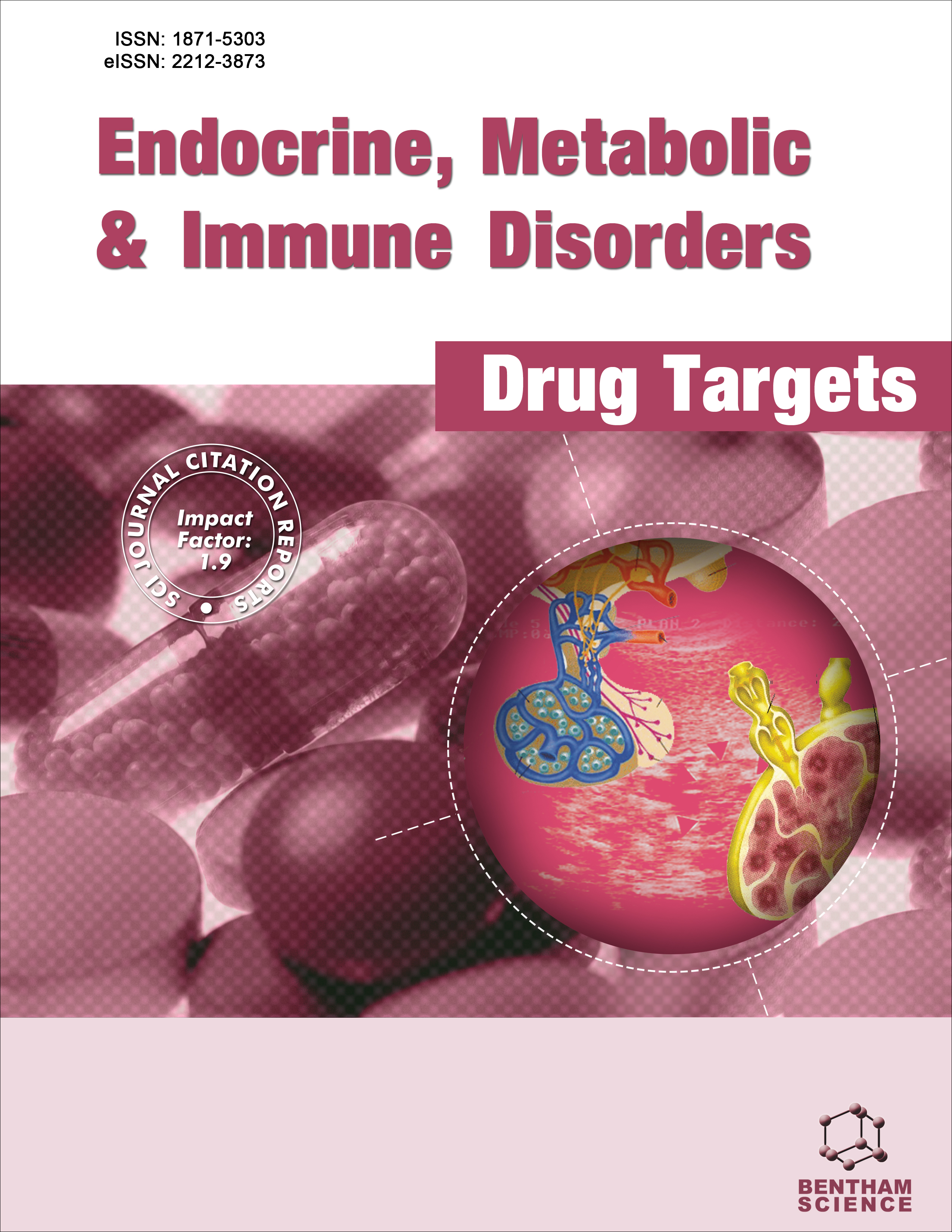- Home
- A-Z Publications
- Endocrine, Metabolic & Immune Disorders-Drug Targets (Formerly Current Drug Targets - Immune, Endocrine & Metabolic Disorders)
- Previous Issues
- Volume 11, Issue 1, 2011
Endocrine, Metabolic & Immune Disorders-Drug Targets (Formerly Current Drug Targets - Immune, Endocrine & Metabolic Disorders) - Volume 11, Issue 1, 2011
Volume 11, Issue 1, 2011
-
-
Pain and Child: A Translational Hypothesis on the Pathophysiology of a Mild Type-2 Diabetes Model
More LessAuthors: S. Loizzo, A. Capasso, A. L. Loizzo, S. Spampinato, G. Campana, A. Di Giannuario, S. Pieretti and A. LoizzoPediatric pain management underwent many changes since the undertreatment of pain in children was reported in the literature in 1980. Increasing data also suggest that long-term behavioural effects can be observed in children, following pain episodes as early as in the neonatal period. Therefore, the knowledge about safe and effective management of pain in children should be applied with greater effectiveness Read More
-
-
-
Cystic Fibrosis and the Innate Immune System: Therapeutic Implications
More LessCystic Fibrosis (CF), the most common autosomal lethal disorder in Caucasians, is caused by mutations in the CF transmembrane conductance regulator (CFTR) gene. Although CF is multi-organ disease, the lung pathology is the chief cause of morbidity and mortality of CF patients. The hallmarks of CF lung disease are respiratory infection by opportunistic pathogens and a deranged inflammatory response. However, clin Read More
-
-
-
The Evil Axis of Obesity, Inflammation and Type-2 Diabetes
More LessAuthors: Arghya Das and Sangita MukhopadhyayObesity and type 2 diabetes (T2D) are global problems affecting all age groups and have been characterized as lifestyle disorders. Though no study has clearly proved a direct correlation between obesity and T2D, a number of factors are associated with obesity causing insulin resistance and T2D. The factors such as adipokines and various transcription factors help to maintain a proper metabolic state in the body. Deregulatio Read More
-
-
-
Human Chorionic Gonadotropin: A Model Molecule For Oligopeptide-Based Drug Discovery
More LessAuthors: Nisar Ahmed Khan and Robbert BennerSmall degradation products of proteins can have regulatory powers in biological systems. We have studied the role of selected oligopeptides derived from the pregnancy hormone human chorionic gonadotropin (hCG) in several (patho)physiological systems. The employed oligopeptides (3 up to 7 amino acids) were designed according to the known nick sites in ‘loop-2’ of β-hCG. These oligopeptides can inhibit severe inflam Read More
-
-
-
TRP Channels and Cancer: New Targets for Diagnosis and Chemotherapy
More LessAuthors: Giorgio Santoni and Valerio FarfarielloThe Transient Receptor Potential (TRP) channels family consists of seven different subfamilies, namely TRPC (Canonical), TRPV (Vanilloid), TRPM (Melastatin), TRPML (Mucolipin), TRPP (Polycystin), and TRPA (Ankyrin transmembrane protein) and TRPN (NomPC-like) that are related to several physiological and pathological processes. Recent years have witnessed an increased interest of research into the connection between T Read More
-
-
-
Application of Innate Immune Molecules for a New Class of Drugs: Infection, Inflammation and Beyond
More LessAuthors: H. J. Kimura, K. Suzuki, M. A. Landek-Salgado, P. Caturegli, N. Jounai, K. Kobiyama and F. TakeshitaThe innate immune system plays an important role systemically and locally in infectious and inflammatory diseases. Vaccines, vaccine adjuvants and anti-inflammatory drugs were developed by understanding mechanisms of the innate immune system and causative factors of infection and inflammatory diseases. Pattern-recognition receptors, such as Toll-like receptors, retinoic acid-inducible gene I (RIG-I)-like helicases and Read More
-
-
-
HLA-G Expression in Cancers: Potential Role in Diagnosis, Prognosis and Therapy
More LessBy Wei-Hua YanHuman leukocyte antigen G (HLA-G) is a non-classic major histocompatibility complex (MHC) class I molecule that functions as an immune suppressive molecule. HLA-G has direct inhibitory effects on natural killer cells (NK), dendritic cells (DC), T cells and has long-term tolerogenic indirect effects by inducing regulator T cells (Treg). HLA-G has been reported to be involved in various physio-pathological conditions suc Read More
-
Volumes & issues
-
Volume 25 (2025)
-
Volume 24 (2024)
-
Volume 23 (2023)
-
Volume 22 (2022)
-
Volume 21 (2021)
-
Volume 20 (2020)
-
Volume 19 (2019)
-
Volume 18 (2018)
-
Volume 17 (2017)
-
Volume 16 (2016)
-
Volume 15 (2015)
-
Volume 14 (2014)
-
Volume 13 (2013)
-
Volume 12 (2012)
-
Volume 11 (2011)
-
Volume 10 (2010)
-
Volume 9 (2009)
-
Volume 8 (2008)
-
Volume 7 (2007)
-
Volume 6 (2006)
Most Read This Month
Article
content/journals/emiddt
Journal
10
5
false
en


